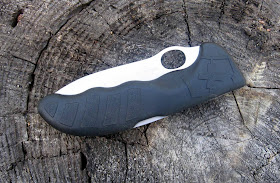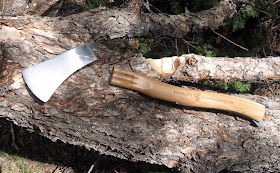Victorinox appears to be taking aim at the growing wilderness survival market with their new and robust Hunter Pro folding
knife. Sporting a one-hand opening, 4" long, 440C Stainless blade, the
Hunter Pro looks to be the biggest and baddest Victorinox knife yet.
In fact, Victorinox is making no bones about who the target audience is for this knife, as evidenced by their promo video, which
shows the Hunter Pro being batoned through a log (yes, folks, the Swiss
Army Knife people are actually batoning a log with this knife-- who da
thunk it?!)
Considering
that Victorinox is more known for polite pocket knives than for serious
survival blades, I find this quite interesting, and it's one more sign
that bushcraft and wilderness survival are growing in popularity.
The SPECS:
Blade Length: 4" (100mm)
Closed Length: 5" (130mm)
Overall Length: 9" (223mm)
Locking Mechanism: Lockback
Blade Steel Type: 440C Stainless
Rockwell Hardness: 56
Handle Thickness: 0.8"
Weight without sheath: 5.7 oz (as measured on a digital postal scale)
Weight with sheath: 6.9 oz (as measured on a digital postal scale)
Made in Switzerland
Street Price: $60-$80 USD
Overview
(click to enlarge)
The handle scales are made from a slip-resistant dual-density, hard rubber:
The Hunter Pro also comes with a nice little olive drab nylon belt case:
FIELD TEST
I
ran the Hunter Pro through a battery of our standard field tests,
including Fine Carving, Food Prep, Batoning and a Tip Strength test. I
wasn't expecting much from a folding knife, but since Victorinox was
touting the Hunter Pro as a "rugged" folding blade, I decided to go hard
on it.
I was pleasantly surprised to find that the Hunter Pro actually lived up
to Victorinox's hype. The handle turned out to be very comfortable and
secure in the hand, and the blade's edge geometry made it an excellent
fine carving knife:
The matte finish on the blade also made food prep a breeze, especially
when cutting blocks of cheese, which tend to stick like glue to knife
blades.
The Hunter Pro also took our rather brutal Tip Strength and Batoning tests in stride. I batoned the blade through a very knotted log, half expecting the lock mechanism to break, or the blade to chip but the Hunter Pro held up with no signs of edge damage, or degradation to the lock mechanism.
The Tip strength test yielded similar results. I stabbed the Hunter Pro's tip repeatedly into a dry pine log and twisted it, to see if it would break, but it held up perfectly.
Unfortunately, a technical glitch with our camera's SD card prevented us from posting the photos of the batoning and tip-strength tests, but I plan to update this review with new photos as soon as time permits.
Steel Quality
In creating the Hunter Pro, Victorinox decided to go with American 440C Stainless Steel, with a Rockwell hardness of 56. I think this was a good decision, as it gives the knife a good combination of toughness and edge retention. I found the Hunter Pro a little easier to sharpen than my standard Victorinox Swiss Army Knives, yet it seemed to hold its edge better.
One-handed Opening
The Hunter Pro's blade has a large thumb hole to facilitate one-handed opening, similar to Spyderco's folding knives. Unfortunately, I found the Hunter Pro's one-hand opening a bit stiff right out of the box. I wasn't terribly surprised by this, as my experience with earlier incarnations of Victorinox's one-handed openers (i.e. the One Handed Trekker, etc) was similar. However, the Hunter Pro did loosen up enough with use that I found it to be an improvement over the One Handed Trekker.
Another minor issue was that right out of the box, there was a small amount of up and down play between the blade and the lock mechanism. Looking around on knife forums, I found this to be a common issue. It didn't seem to affect the knife in any way while batoning, but I wanted to mention it.
Conclusion
The Hunter Pro turned out to be a ruggedly built folding blade that proved its durability during our harsh batoning and tip strength tests. It was comfortable in the hand, and surprisingly good at wood carving. I think Victorinox fans who are looking for a larger, more capable outdoor knife will be well-pleased with the Hunter Pro.
4 out of 5 Stars (Recommended)
For more information, visit Victorinox's website at:
 Jason Schwartz is the founder and senior editor of Rocky Mountain Bushcraft. He is a former Red Cross certified Wilderness & Remote First Aid Instructor, and has taught bushcraft and wilderness survival techniques to the Boy Scouts of America, interned with the US Forest Service, and studied wilderness survival, forestry and wildland firefighting at Colorado Mountain College in Leadville, Colorado. Jason has also written for magazines such as The New Pioneer and Backpacker, including writing the "Tinder Finder" portion of Backpacker's "Complete Guide to Fire," which won a 2015 National Magazine Award (NMA). Email him at rockymountainbushcraft @ hotmail.com (without spaces)
Jason Schwartz is the founder and senior editor of Rocky Mountain Bushcraft. He is a former Red Cross certified Wilderness & Remote First Aid Instructor, and has taught bushcraft and wilderness survival techniques to the Boy Scouts of America, interned with the US Forest Service, and studied wilderness survival, forestry and wildland firefighting at Colorado Mountain College in Leadville, Colorado. Jason has also written for magazines such as The New Pioneer and Backpacker, including writing the "Tinder Finder" portion of Backpacker's "Complete Guide to Fire," which won a 2015 National Magazine Award (NMA). Email him at rockymountainbushcraft @ hotmail.com (without spaces)





























